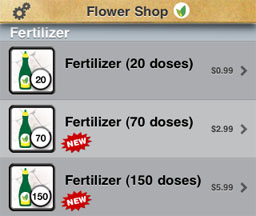 In-game point bundles are nothing new. Even before the time of in-app purchases, Zynga was famous for releasing “points” apps to increase your game reputation or other stats. The fact that they released not just one way of getting points, but many different apps at different price points, was something I dismissed as a marketing tactic to try to get noticed on the charts.
In-game point bundles are nothing new. Even before the time of in-app purchases, Zynga was famous for releasing “points” apps to increase your game reputation or other stats. The fact that they released not just one way of getting points, but many different apps at different price points, was something I dismissed as a marketing tactic to try to get noticed on the charts.
Fast-forward to now, and as more companies are jumping into the bandwagon of games that need “points” to make progress, we’re still bundles. Again, I chucked that up to legacy reasons and doing what worked with the standalone apps.
Discovering Bundles
It was at the last 360iDev in San Jose, that Mark Johnson said something that really stuck with me. I can still hear him say it with his fine British accent: “I think we might be underestimating how much people are willing to pay for in-app purchases”. Really?
As soon as I had a chance, I looked at the best-selling IAPs for some popular games. The screenshots below were taken today, not back when I looked at them, but the results are very much the same. I let you guess which games these IAPs came from.
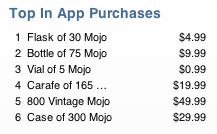
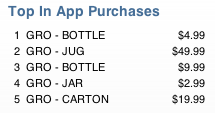

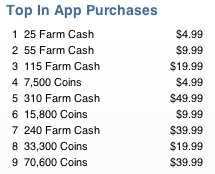
I was very surprised with what I saw. The top-selling IAP was never a $0.99 one, and there were bundles of $49.99 or higher towards the top! That was crazy! I was indeed underestimating what players are willing to buy by only offering a measly $0.99 fertilizer bottle in Flower Garden!
Bundles In Flower Garden
As part of the next Flower Garden update, I decided to run a little experiment and add two more fertilizer options: A $2.99 one and a $5.99 one, each of them giving you a slightly better deal on fertilizer (20, 70, and 150 doses). That was still nothing compared to the price tags I was seeing in those other games, but I didn’t want to alienate users by slapping some ridiculously high bundle prices.
The results?
The most popular item by number of sales was still the single fertilizer bottle for $0.99. But a lot of people took advantage of the the other two bundles as well. This is how fertilizer sales for Flower Garden Free have been for the last two months:
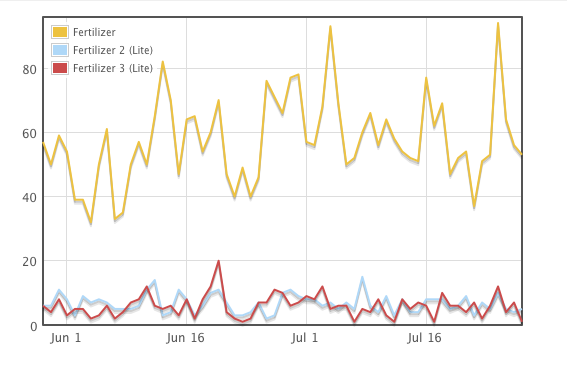
But now, let’s look at that same period by plotting revenue (again, only Flower Garden Free, the full version is very similar but it wasn’t easy to combine the two to display them here):
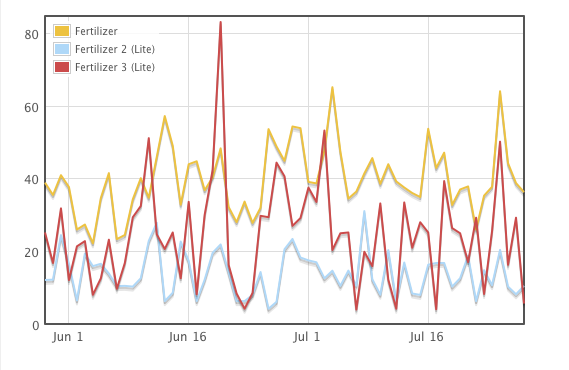
Now the two bundles are a lot closer to the single bottle, especially the larger, $5.99 bundle.
More Than Meets The Eye
In the end, were bundles effective, or are people buying the same amount of fertilizer and leaving less money in the process? Unfortunately I can’t answer that question from a pure data point of view. Looking at fertilizer sales before and after I introduced the bundles is no good because the number of users increased dramatically at each update. I can’t even normalize them by the number of sales, it would have to be by the number of daily users, and unfortunately that’s not a statistic that I’m tracking.
However, I think we can argue two really good points about why bundles are great.
1. More choice
Having different levels of bundles give players more choice on how they want to purchase something. From what I’ve read about buyer psychology, people love having choices when buying something (just don’t give them too many choices!). They are more involved in the buying process, they evaluate it, and they feel better about the decision they eventually make. So that seems to indicate that more people might buy fertilizer if there are a few bundle options than if there’s only one.
2. Commitment
This is the biggie. Whenever a user purchases a $5.99 bundle (or a $49.99 one!), they became more committed to your game. You can also guarantee they will come back again to get their money’s worth from that purchase. Even if they had the intention of coming back to your game without the purchase, having spent that money is a nice reminder to do so. And having people come back to your game is what this is all about: They will explore more of the game, get hooked more, make more in-app purchases, show it to more of their friends, and send more bouquets to their family.
I have no doubt that I’ll be using bundles in the future. Players get a good deal, and you get committed players. It’s a win-win situation.
This post is part of iDevBlogADay, a group of indie iPhone development blogs featuring two posts per day. You can keep up with iDevBlogADay through the web site, RSS feed, or Twitter.
Here we go: IAP Bundles: More Than Just Good Deals http://gamesfromwithin.com/iap-bundles-m… #idevblogaday
I’ve been thinking more and more about price structure and IAP for my iPad project. I don’t think bundles will have a place in the project but they definitely will when I build a companion iPhone project. Pretty amazing to see some of the loyality out there ($49.99!).
I think some developers would be surprised at how loyal their players can be – often they are hungry for more, want to support the developer and are perfectly willing to pay if given the opportunity.
On the free version of one of our iPad apps, we offered an in-app upgrade to the premium version. Users were given the option of two price points, both unlocking the same functionality.
An astonishing 20% went for the higher price (2.5x as expensive). This wasn’t even offering anything extra, just simply making the option available.
Anyway, this isn’t really about bundles, more about the value people are willing to attach to a product and how it can be higher than you think.
@SnappyTouch What does ‘TZ’ mean, and why do you re-tweet yourself? #iamanewb
Noel — what do you think about bundling non-consumables? My next game will offer different themes that can be purchased via IAP. Your post got me to thinking that perhaps I could offer groups of themes at a discounted rate (i.e. instead of $1.99 ea, the bundle would offer 3 themes for $4.99). I don’t think that the bundle would be a la carte — I would have to group the themes into bundles. Perhaps another enticement: purchase all bundles currently available and any that become available in the future for a one time price of $4.99 (or whatever).
Unlike consumables, these bundles don’t encourage the user to come back and use the app — but maybe the thought of a deal (save a buck!) might push the user from a $1.99 sale to a $4.99 sale
Anyway, thanks for another great post. Got me thinking
tom
Hey Tom, Good question! I don’t really know. As you pointed out, it doesn’t have the draw of coming back to the app as much as a consumable item. People who buy IAPs, usually like your game quite a bit, so my guess is that they would buy those items no matter what.
It would be really interesting if, without changing any other conditions, you quietly introduced the bundle for a week, and then compared purchases with how things were before. If so, I want to hear all about the results! 🙂
You absolutely should watch this TED talk by Dan Ariely:
http://www.ted.com/talks/dan_ariely_asks_are_we_in_control_of_our_own_decisions.html
Especially the bit starting at 12:30.
I was going to point out Dan Ariely’s first chapter from Predictably Irrational which talks about presenting 3 choices to the user: A, B, and ~A in which case they always choose A. He demonstrates this with the 3 choices from the Economist’s website for subscriptions. Essentially you are given a choice between the print edition: Economist.com subscription for $59.99, Print subscription for $125 or Print & Web for $125
Essentially the Print & Web one looks like a better deal because it’s easy to compare to the Print only edition and our brains are lazy when they do comparisons so they never consider the Web only edition from ‘base principles’ when making the decision. Essentially, the way you’ve presented the choices has triggered a logical bug in our brains.
There’s a much better explanation in the book, but I think this could really drive revenue if you offered something in a similar way and I’d love to hear the results.
We’re building our first IAP so naturally I’ve been reading your IAP stuff and I see myself quoted :-). We’re probably going price at $1.99 for ‘Six more opponents’ in Hit Tennis. I think there is a huge difference between a 99c app and a 99c IAP. App pricing effects both sales and chart ranking, and chart ranking drives sales, hence the attractiveness of 99c. But IAPs don’t effect ranking, someone you show an IAP to is already a customer, already invested, and there’s a good chance they want to buy from you. So no need to stay at 99c. (That said, I think 99c is a good price for your flower garden consumables.) Our strategy going forward is: wide appeal free apps + ‘getable’ app name & icon + ads + IAPs.
I just watched the Dan Ariely vid that Hendrick posted. Wow.